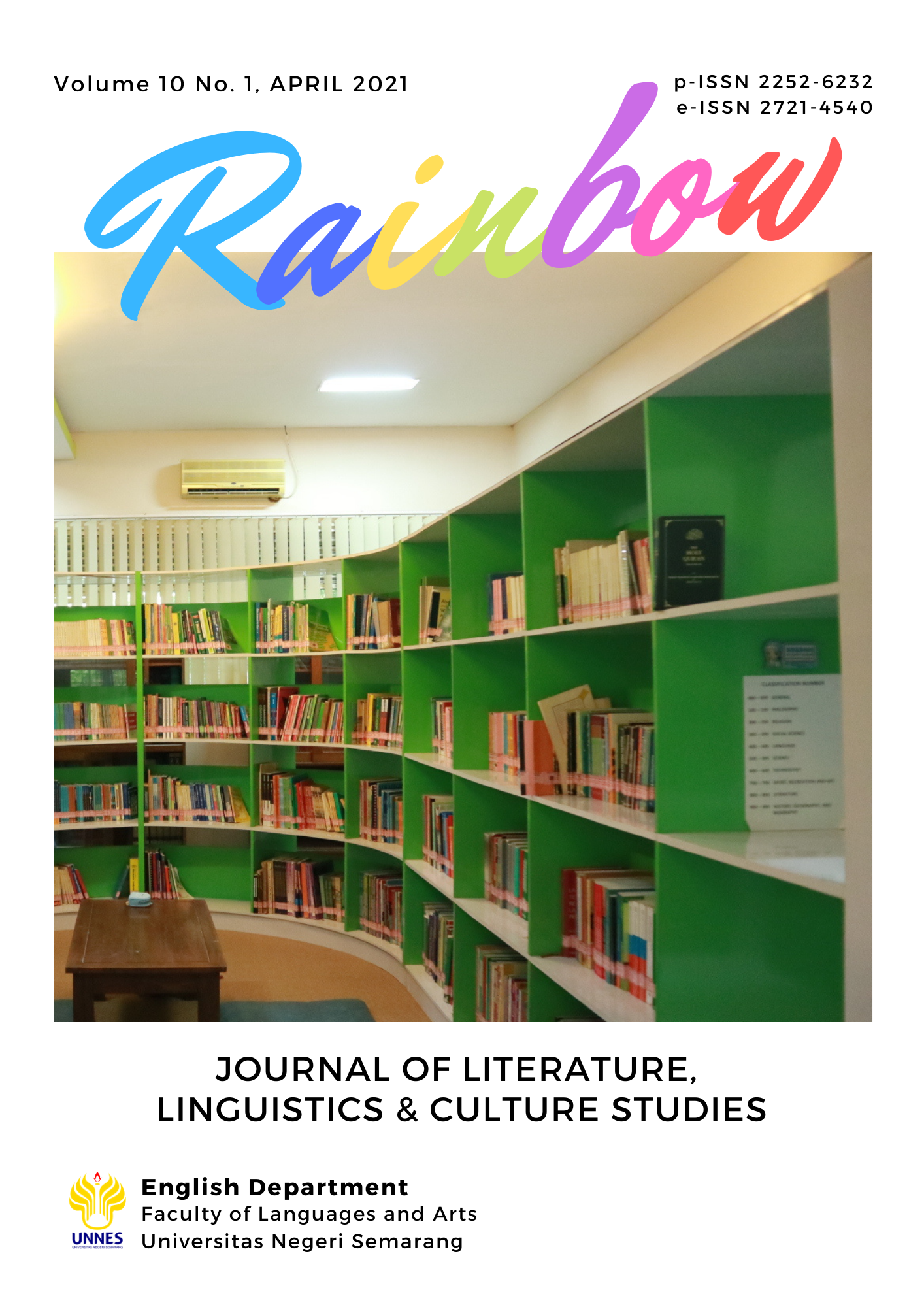Within Indian wars and the Wounded Knee massacre
Native Americans’ self-determination in 'Bury Me at Wounded Knee'
Abstract
Besides recorded in textbooks, historical events sometimes are adopted into literary works. Rebecca Wiles’ Bury Me at Wounded Knee is one of which since it portrays the Indian Wars and the Wounded Knee Massacre on 29 December 1890. The clause Bury Me at Wounded Knee in the poem is a form of self-determination of Native Americans. This paper aims at mapping the causal relation of historical events found in the poem to examine the Native Americans’’ self-determination inside it. As the basis, the paper employs the Historicism theory and Self-Determination theory (SDT) about autonomous and controlled motivations. The results found that the Native Americans’ self-determination in the poem is an undermined one. It is built by their internal autonomous motivation of deeply rooted culture and beliefs. However, the encroachments of the U.S. government who seized their rights, acted as controlled extrinsic motivations, internalized and thwarted the intrinsic motivation so that the self-determination is undermined. It decreases in the degree from an eagerness to act and resist to merely a wish of being buried in the location where they die and think of extinction.
References
Nurcahyo, R. (2020). The Narrative World of Native Americans Seen from the Adaptation of Ohiyesa in Bury My Heart at Wounded Knee. LITERA, 19(2), 297-309.
Zanjabila, F. (2017). Representation of United States Expansions to Sioux Indian Tribes (Bachelor’s thesis, State Islamic University Syarif Hidayatullah, Jakarta, 2017). Jakarta: State Islamic University Syarif Hidayatullah
Yu Media Group. (n.d.). South Dakota, USA – Climate Data and Average Monthly. Weather Atlas. Retrieved from https://www.weather-us.com/en/south-dakota-usa-climate.
Bevir, M. (2015). Historicism and Critique. Philosophy of the Social Sciences, 45(2), 227-245. DOI: 10.1177/0048393114531370.
Danspeckgruber, W. & Gardner A. (n.d.). Self-Determination. The Encyclopedia Princetoniensis. Retrieved from https://pesd.princeton.edu/node/656.
Deci, E. L. & Ryan, R. M. (2008). Self-Determination Theory: A Macrotheory of Human Motivation, Development, and Health. Canadian Psychology, 49(3), 182-185. DOI: 10.1037/a0012801.
Deci, E. L. (2017). Intrinsic Motivation and self-determination. In J. Stein et al. (Eds.). (2017). Reference Module in Neuroscience and Biobehavioral Psychology. Elsevier. https://doi.org/10.1016/B978-0-12-809324-5.05613-3.
Estes, N. (2013). Wounded Knee: Settler Colonial Property Regimes and Indigenous Liberation. Capitalism Nature Socialism, 24(3), 190-202. https://doi.org/10/1080/10455752.2013.814687.
Geronimo. (1906). Geronimo’s Story of His Life. (S. M. Barret, Ed.) The Project Gutenberg Ebook. New York: Duffield & Company. Retrieved from http://www.gutenberg.org/files/31318/31318-h/31318-h.htm.
Grua, D. W. (2015). “In Memory of the Chief Big Foot Massacreâ€: The Wounded Knee Survivor and The Politics of Memory. Western Historical Quarterly, 46(1), 31-35. https://www.jstor.org/stable/10.2307/westhisquar.46.1.0031.
Hamilton, P. (2003). Historicism (2nd Ed.). London: Routledge.
Hillstrom, K. & Hillstorm, L. C. (2010). Defining Moments American Indian Removal and The Trail to Wounded Knee. Detroit, Mich: Omnigraphics.
Kelley, D. R. (2015). Historicism. In J. D. Wright (Ed.). International Encyclopedia of the Social and Behavioral Sciences (2nd Ed.). Elsevier. http://dx.doi.org/10.1016/B978-0-08-097086-8.62135-9.
Legault, L. (2017). Self-Determination Theory. In V. Zeigler-Hill and T.K. Shackelford (Eds.). Encyclopedia of Personality and Individual Differences. Springer International Publishing. DOI: 10.1007/978-3-319-28099-8_1162-1.
Meyer, C. A. (2019). From Wounded Knee to Sacred Circles: Oglala Lakota Ethos as “Haunt†and “Woundâ€. Humanities, 36(8), 1-22. DOI: 10.3390/h8010036.
Roscigno, V. J. & Cantzler, J. (2015). Legitimation, State Repression, and the Sioux Massacre at Wounded Knee. Mobilization: An International Quarterly, 20(1), p. 17-40. DOI: 10.17813/maiq.20.1.pj9n771ph6181p06.
Roth, R. (2012). Wounded Knee: Party Politics and the Road to and American Massacre (Review). The Journal of the Civil War Era, 2(1), 116-118. https://doi.org/10.1353/cwe.2012.0006.
Ryan, R. M. & Deci, E. L. (2000). Self-Determination Theory and the Facilitation of Intrinsic Motivation, Social Development, and Well-Being. American Psychologist, 55(1), 68-78. DOI: 10.1037//0003-066X.55.1.68.
Shoemaker, N. (1999). American Indian Population Recovery in the Twentieth Century (1st Ed.). Albuquerque: University of Nex Mexico Press.
Sudiro, S. (2020). The Depiction of Native Americans in the Novels of Forrest Carter. IJLLC, 7(1), 13-29. DOI: 10.19044/llc.v7nola2.
Wiles, Rebecca. (2007, June 3). Bury Me at Wounded Knee. Poem Hunter. Retrieved from https://www.poemhunter.com/poem/bury-me-at-wounded-knee/







